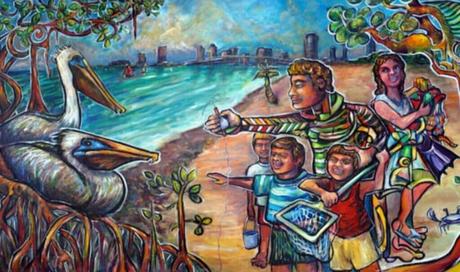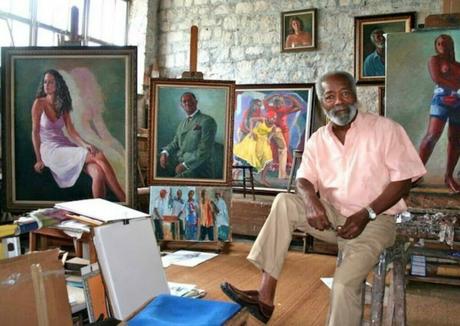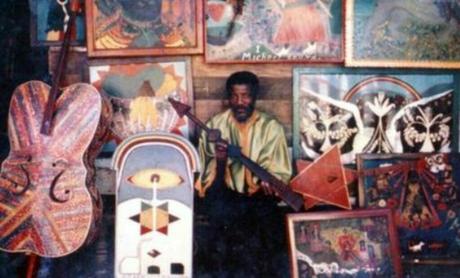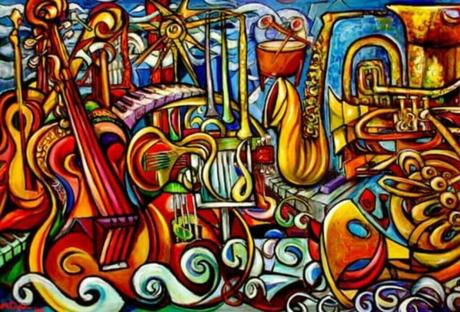Jamaican art history is rich and lively, spanning numerous art movements that not only molded the local aesthetic environment but also had a significant impact on the worldwide art scene.
From the Intuitive Movement of the 1930s to the contemporary expressions of Rastafarian and Reggae Art, Jamaican artists have captured the essence of their country’s culture, history, and identity. The influence of Jamaican art extends beyond the island, inspiring artists worldwide and permeating various aspects of global culture, from music and fashion to interior design.
This article explores the early art movements in Jamaica, notable Jamaican artists, and the lasting impact of Jamaican art on the world stage.
Early Jamaican Art Movements

Jamaican art has a rich history, marked by a vibrant and distinct blend of influences from its indigenous people and colonial past. From the early Taino artifacts to the visual storytelling of plantation life, Jamaican art has been a way for its people to express their experience and identity. The emergence of the Intuitive Movement in the 1930s brought forward self-taught artists who used their unique perspectives to paint the Jamaican landscape, capturing the spirit of the land and its people in a powerful and evocative manner.
The 1960s saw a cultural renaissance with Jamaica’s independence. Artists began to break away from European artistic traditions, exploring new mediums and styles to portray their newfound national pride and to narrate their own stories. The formation of the Contemporary Jamaican Artists’ Association aimed to foster this nationalistic sentiment, encouraging artists to create works that reflected Jamaican society, politics, and culture.
Diverse Art Movements in Jamaican Culture
Examples of Jamaican art movements during this period include:
- The Intuitive Movement: Artists like John Dunkley, David Miller Sr., and Mallica “Kapo” Reynolds emerged during the 1930s and 1940s, creating artwork that emphasized their intuitive and spiritual connection to the Jamaican landscape. Their paintings often depicted scenes of rural life, vibrant flora, and fauna, showcasing a deep appreciation for the natural environment.
- The Nationalist Movement: In the wake of Jamaica’s independence in 1962, artists embraced a sense of national pride and began exploring their own cultural identity. Barrington Watson, Carl Abrahams, and Karl Parboosingh were prominent artists who sought to capture the essence of Jamaican society and history through their art. They highlighted topics such as Afro-Jamaican history, working-class problems, and the beauty of the island’s varied inhabitants.
- The Jamaica School of Art: Founded in 1950, the Jamaica School of Art was instrumental in developing creative talent and supporting indigenous aesthetic expression. It provided formal training to aspiring artists, encouraging them to explore various mediums and techniques. During this time, the school had a huge impact on the development of Jamaican art, inspiring numerous artists who went on to contribute to the country’s art scene.
- The Roots Movement: A new generation of Jamaican artists arose in the 1970s and 1980s, heavily influenced by Rastafarian culture and ideology. Artists like Ras Dizzy, Everald Brown, and Ras Akyem-I Ramsay incorporated elements of Rastafarianism, African spirituality, and Jamaican folklore into their work. Their art celebrated the African diaspora, emphasized cultural pride, and challenged societal norms.
- The Reggae Art Movement: With the rise of reggae music as a global phenomenon, artists found inspiration in the vibrant energy and social commentary of this musical genre. Painters such as Albert Huie, Mallica “Kapo” Reynolds, and Eugene Hyde created artwork that reflected the spirit of reggae, incorporating its themes of social justice, spirituality, and love. Their paintings often featured musicians, dancers, and scenes of Jamaican street life, capturing the essence of the reggae movement.
These art movements not only contributed to Jamaica’s cultural environment, but also affected and inspired artists from other countries, creating a lasting impression on the Caribbean art scene and the worldwide art world.
Notable Jamaican Artists

Among Jamaica’s treasure trove of artists, Edna Manley stands out as a pivotal figure. Often referred to as the “Mother of Jamaican Art,” Manley’s work is a testament to her country’s struggles and triumphs. Her sculptures, often described as modernist and Afro-centric, played a significant role in creating a visual language for the Jamaican nationalist movement.
Another influential artist, Albert Huie, is often considered the father of Jamaican painting. His landscapes and portraits from the 1930s and beyond offer a captivating insight into Jamaican life and identity, illustrating everything from rural landscapes to the social life of the time. His vivid palette and impressionistic style immortalize the beauty and vibrancy of Jamaica and its people.
Celebrating Notable Artists
Edna Manley:
- Edna Manley is known as the “Mother of Jamaican Art” for her contributions to the country’s cultural scene.
- Her sculptures, characterized by modernist and Afro-centric aesthetics, became iconic symbols of Jamaican identity and the nationalist movement.
- Through her artwork, Manley captured the struggles, triumphs, and cultural heritage of Jamaica, showcasing a deep understanding of the country’s history and people.
Albert Huie:
- Albert Huie, often regarded as the father of Jamaican painting, played a crucial role in shaping the artistic narrative of the nation.
- His landscape and portrait paintings from the 1930s onwards offer a captivating glimpse into Jamaican life and identity.
- Huie’s use of vivid colors and impressionistic style beautifully immortalizes the natural beauty, vibrant culture, and social life of Jamaica.
Other notable Jamaican artists include:
- Barrington Watson: Watson was a prominent figure in the Jamaican art scene, known for his realistic and emotionally powerful portraits. His work explored themes of identity, race, and social justice, contributing to the cultural discourse of the nation.
- Cecil Baugh: Baugh was a renowned ceramicist whose work showcased intricate designs and craftsmanship. His ceramic pieces, often inspired by Jamaican flora and fauna, have become highly sought after both locally and internationally.
- Ebony G. Patterson: Patterson is a contemporary Jamaican artist known for her visually stunning mixed-media works that explore themes of identity, gender, and violence. Her vibrant and intricately detailed pieces challenge societal norms and invite viewers to reflect on complex issues.
These noteworthy Jamaican painters have made important contributions to the art world, both locally and internationally. Their unique perspectives, artistic skills, and cultural insights have enriched the global art scene and continue to inspire generations of artists.
Influence of Jamaican Art on the World

Jamaican art has had an unquestionable influence on the international art landscape. The Intuitive Movement has attracted international attention, with renowned artists like Mallica “Kapo” Reynolds and Everald Brown gaining recognition for their raw, powerful, and deeply spiritual works. The movement’s emphasis on self-taught artistry and individual expression has resonated globally, challenging the traditional confines of art.
Furthermore, Jamaican art has played an important part in developing the Rastafarian and Reggae Art movements, both of which have gained international acclaim. The visual language of the art, saturated with Jamaican flag colors and Rastafarianism symbols, has been essential in propagating Jamaican culture abroad. From music album covers to fashion and interior design, the influence of Jamaican art continues to permeate various aspects of global culture, solidifying its place on the world stage.
From Local Roots to Global Impact
Jamaican art has crossed borders and had a significant effect on the worldwide art landscape. Here are some key ways in which Jamaican art has influenced the world:
The Intuitive Movement:
- Artists like Mallica “Kapo” Reynolds and Everald Brown, with their raw and spiritually charged works, have captivated international audiences.
- The movement’s emphasis on self-taught artistry and individual expression has challenged traditional artistic norms and resonated with artists and art enthusiasts worldwide.
Rastafarian and Reggae Art:
- Jamaican art has had a significant impact on the visual languages of the Rastafarian and Reggae Art movements.
- The brilliant colors of the Jamaican flag, paired with Rastafarianism emblems, have become iconic icons of Jamaican culture and are well known across the world.
- Jamaican art may be seen in a variety of forms, including record covers, fashion, interior design, and visual depictions of reggae music, all of which provide a visual connection to the island’s rich cultural legacy.
Cultural Permeation:
- Jamaican art, with its vibrant colors, rich symbolism, and powerful narratives, has permeated various aspects of global culture.
- It has influenced fashion trends, inspiring designers and artists around the world to incorporate Jamaican motifs and aesthetics into their creations.
- Jamaican art has also influenced interior design, with its bold and expressive style adding a touch of Caribbean flair to spaces worldwide.
Jamaican art has left an everlasting effect on the global art landscape via its numerous trends and prominent artists. Its distinct combination of cultural history, individual expression, and dramatic storytelling has caught the minds of people from all walks of life, cementing its position as a worldwide known and respected art form.
Jamaican Art History FAQ

What Is The Origin Of Jamaican Art?
Jamaican art has its origins in the island’s rich cultural legacy, which has been impacted by many historical periods and ethnic groupings. It draws inspiration from the artistic traditions of the indigenous Taino people, the African slaves brought to Jamaica, and later, the European colonial powers that occupied the island.
What Type Of Art Is Jamaica Known For?
Jamaica is well-known for its bright and expressive visual arts, notably painting, sculpture, and ceramics. The country is celebrated for its dynamic and colorful representations of daily life, folklore, religion, and social commentary. The art often embodies the spirit of Jamaican culture and is characterized by its bold use of color, symbolism, and rhythmic patterns.
When Did Jamaican Art Start?
Jamaican art has a lengthy history, stretching back to pre-Columbian times with the indigenous Taino people’s artistic traditions. However, it saw substantial development and recognition following independence in the mid-twentieth century. This period saw the emergence of notable Jamaican artists, such as Edna Manley and Albert Huie, who played pivotal roles in shaping the country’s modern art scene.

